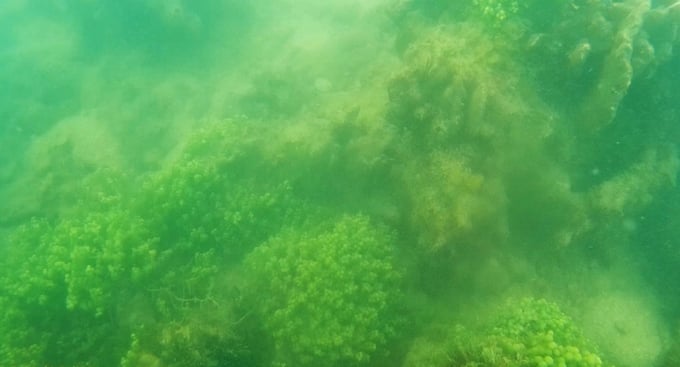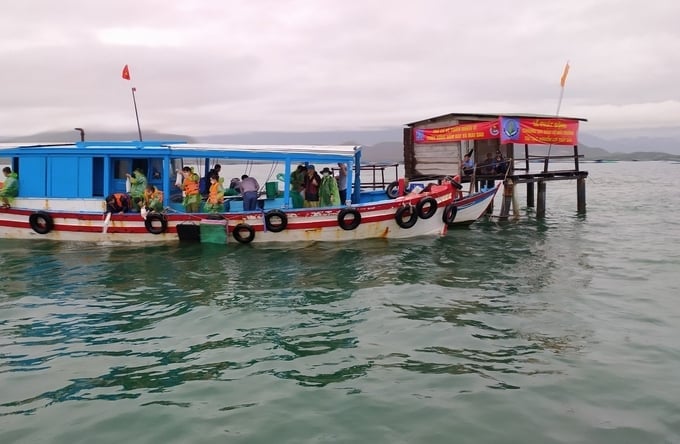June 2, 2025 | 05:00 GMT +7
June 2, 2025 | 05:00 GMT +7
Hotline: 0913.378.918
June 2, 2025 | 05:00 GMT +7
Hotline: 0913.378.918
The Ran Trao marine ecosystem conservation area is situated in Van Hung commune, Van Ninh district, Khanh Hoa province, covering an area of 89 hectares. Notably, 54 hectares of the conservation area constitute the core zone, where the coral reef ecosystem is relatively rich and diverse in terms of species composition and coverage density.

The Ran Trao marine ecosystem conservation area has received enhanced protection over the last few years. Photo: KS.
Recent survey and research data indicate that the Ran Trao marine area boasts a rich and diverse marine flora and fauna, with a relatively high coral coverage density and quality compared to that of other areas within Van Phong Bay. More than 50% of the discovered aquatic species in the Van Phong Bay region are found in the Ran Trao area. Accordingly, corals account for 64%, reef fish 69%, and seagrass 75%.
Before the Ran Trao marine area was assigned to the local government's management and protection, its ecosystem and aquatic resources faced numerous challenges, experiencing widespread degradation due to various factors. These included destructive fishing practices (such as the use of small-meshed gear, blast fishing, and electric shock fishing), coral harvesting for handicrafts and artistic purposes, and sales to tourists. These activities rapidly depleted the aquatic resources and coral reef ecosystem.
In response to these issues, the Ran Trao marine ecosystem conservation area was established in 2008 with the goal of delineating a protected zone to safeguard the breeding grounds of aquatic species, protect the marine environment, conduct scientific research, support educational visits, develop livelihoods, and invite sponsored projects both domestically and internationally.

Joining hands to protect the environment for the regeneration of aquatic resources in the Ran Trao marine ecosystem. Photo: KS.
Following its establishment, the Ran Trao marine ecosystem conservation area received support from non-governmental organizations such as the Marine Conservation and Community Development Center (MCD) and the Coastal Resources for Sustainable Development (CRSD) project.
After years of delineated protection, efforts in safeguarding and developing the Ran Trao marine ecosystem have yielded positive results.
According to a survey conducted by the Khanh Hoa province's Sub-Department of Fisheries and related agencies in 2020, local coral reefs and seagrass have thrived with a dense population, including both hard and soft corals. Additionally, various species of reef fish, shrimp, crab, snails, sea cucumbers, and sea urchins have congregated in the coral reefs within the conservation area.
With the aim of promoting sustainable coastal economic development, creating employment opportunities, increasing income, improving the livelihoods of local residents, and protecting coastal resources, with a focus on the coral reef ecosystem in the Ran Trao marine area, the Khanh Hoa province's Sub-Department of Fisheries, the local Fisheries Association, the Van Ninh District People's Committee, the Van Hung Commune People's Committee, MCD, and the local community have jointly established the "Community Alliance for the Protection of Ran Trao Aquatic Resources." This alliance aims to implement co-management for the protection of aquatic resources in accordance with Article 10 under the 2017 Law on Fisheries and Government Decree No. 26 dated March 8, 2019, detailing specific provisions and measures for the implementation of the Law on Fisheries.

The local coral reef ecosystem and aquatic resources have gradually undergone restoration. Photo: KS.
The Van Ninh District People's Committee issued Decision No. 181 on February 21, 2023, detailing the recognition and delegation of management authority to a community organization for co-management in protecting the aquatic resources of the Ran Trao marine ecosystem.
Mr. Dao Ngoc Thanh, a specialist at the Fisheries Division under the Khanh Hoa province's Sub-Department of Fisheries, tasked with supporting co-management activities in the protection of aquatic resources in the Ran Trao marine ecosystem, stated that this is a suitable management solution to simultaneously promote the livelihoods of the community and protect the coastal coral reef ecosystem. This approach aims to develop aquatic resources and create a landscape for eco-tourism development in the near future.
Mr. Huynh Ngoc Sang, Vice Chairman of the Van Hung Commune People's Committee and Head of the Community Alliance for the Protection of Ran Trao Aquatic Resources, reported that the alliance currently consists of 68 members, including a representative board of 14 individuals. The alliance has established operating regulations and plans for implementing co-management of the aquatic resources in Ran Trao. Accordingly, the alliance has formed three teams focusing on communication, livelihood, and protection, each with seven members. The protection team includes members from the Border Guard Station and the Fisheries Surveillance Station in Van Ninh district, serving as effective forces in conducting regular patrols to apprehend violations within the delegated management area.

Van Ninh district has recognized and delegated management authority to a community organization for co-management in protecting the aquatic resources of the Ran Trao marine ecosystem. Photo: KS.
According to Mr. Huynh Ngoc Sang, since the establishment of the community alliance and their participation in advocacy and protection of the Ran Trao marine ecosystem, local residents have actively responded to the importance of protecting aquatic resources for long-term livelihoods.
"Residents in the commune are increasingly aware of the importance of preserving the marine ecosystem and aquatic resources. This is most evident in the cessation of destructive fishing practices by local residents in the Ran Trao area, thanks to the active efforts of the community management and the support of local governments," shared Mr. Sang. Additionally, he stated that the community management team's future plans include developing eco-tourism to ensure sustainable livelihoods for the local residents. Accordingly, they will collaborate with businesses to organize coral viewing tours using glass-bottom boats and rowing boats. On the other hand, they will research and develop environmentally friendly aquaculture for various species.
Mr. Dao Ngoc Thanh stated that the formal establishment of the co-management model in the Ran Trao marine ecosystem has provided local fishermen with a comprehensive understanding of their rights and responsibilities when participating in the model. It has also created positive ripple effects in coastal communes and wards throughout Van Ninh district.
Translated by Nguyen Hai Long

(VAN) Several scientists and farmers are experimenting with soil treatment in some key durian-growing regions such as Cai Lay (Tien Giang), Dak Song, Gia Nghia, and Dak R’lap (Dak Nong).
/2025/05/25/4127-3-073637_820.jpg)
(VAN) Thanks to the promotion from an FAO-implemented project, vegetable production in greenhouses in Moc Chau has seen strong development, from 1.5 hectares in 2021 to nearly 50 hectares in 2024.

(VAN) FAO has recently supported USD 140,000 to implement the project 'Risk mitigation human-animal interface risks through disease control initiatives in pig farming.'

(VAN) The People's Committee of Tra Vinh province has approved an adjustment to the investment policy for the Green Hydrogen Plant project, increasing its area to approximately 52.76 hectares.
![Reducing emissions from rice fields: [2] Farmers’ commitment to the soil](https://t.ex-cdn.com/nongnghiepmoitruong.vn/608w/files/news/2025/05/05/dsc08881jpg-nongnghiep-140632.jpg)
(VAN) Clean rice cultivation model in Thuong Tan commune, Bac Tan Uyen district, is assisting local residents in achieving sustainable agriculture by substantially reducing costs, increasing productivity, and protecting the environment.

(VAN) At the conference to disseminate Resolution No. 68, AgriS introduced its digital agricultural ecosystem and reaffirmed its commitment to accompanying the Government in promoting private sector development and sustainable agriculture.

(VAN) 'Blue Ocean - Blue Foods' initiative is designed to restore marine ecosystems and establish sustainable livelihoods for local communities by cultivating a minimum of 1,000 hectares of cottonii seaweed in the first three years.